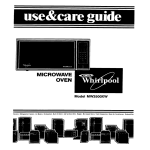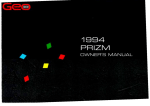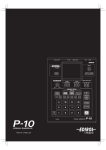Download Comdial Solo II Tele..
Transcript
COMDlAL SoloII TeleDhone This publication is applicable for the following Solo II Telephone models: 5531 -xx Manufacturing Code REV E and Later 5531 S-xx Manufacturing Code REV F and Later 5432X-xx Manufacturing Code REV A and Later 15432S-xx Manufacturing Code REV A and Later User’s Guide :’ Table of Contents BASIC OPERATION OPTIONS Speakerphone operation ~~~~,,~~~~~~..~...~~~~,~~,,~..~~.~~~~~~~~~~~~~~~ 11 ... 111 / SPKR KEY SPEUERPHOHEYOrEL51 .MUERPHOWE OH/OFF/ HANDSET CORD JACK MONITOR KEY . HAWOSFREE CKL YO”ITOR,Y . DO“OT DISTURB II/ I I \lI‘an II L-ii I MICROPHONE OPENING ISPEhxE(ERPHO”E YOULSl LINE PULL OUT DIRECTORY KEYS- STATION POWER SUPPLY TRANSFORMER ‘L’NE ’ KEYCO”FERE”C,“O ON LEFT’ . Ew8l.E TELEPHONE Solo II Controls and Indicators POWER CORD Basic Operation BASIC OPEl?ATlON PLACING A CALL On Hook l Press line key. Listen for dial tone. l Dial number. l Lift handset when party answers. l Hang up handset to end call. Off Hook l Lift handset. l Press line key. (This step is not necessary if idle line preference has been assigned to station.) l Listen for dial tone. l Dial number. l Hang up handset to end call. ANSWERING A CALL l l Press flashing line key. (This step not necessary if ringing line preference is assigned and is ringing) Lift handset PLACING A CALL ON HOLD l Press. HOLD. To return to call on hold, l Press flashing line key. NOTE: Any station can retrieve held call. HOLD RECALL - A held call will automatically sound three tone bursts at the station which placed it on hold after a programmed period of time. : Basic Operation ABANDON HOLD DETECTION - If a distant party hangs up and the host system provides disconnect supervision, the holding station will: l Drop line from hold condition l Turn off tine status indicator PLACING INTERCOM CALLS Voice Announcing l Lift handset. l Press ITCM. l Press station number memory key (in memory key field) for desired station. 0 Voice announce message. l Wait for reply or hang up. Tone Ringing l While on hook, press ITCM. l Press station number memory key twice. When party answers, l Lift handset to talk. ANSWERING INTERCOM CALLS To answer a voice announced intercom call, l Lift handset to talk. or tone ringing TRANSFERRING OUTSIDE CALLS If the line on which the call appears is shared by you and the station to receive the call, l Press ITCM.(Call is placed on hold automatically.) l Press station number memory key for the desired station. l Voice announce the call and line number. l Hang up handset. If the line on which the call appears is not shared by you and the station to receive the call, l Use host system transfer facility. NOTE: See TAP/Recall discussion. 2 /: Basic Operation CONFERENCE CALLS Multiline Conference for 2 external parties and 1 internal NOTE: Conference transmission levels are not compensated and connections of parties must be supervised by one inside party. l Establish first outside call and press HOLD. l Establish second outside call. l Press and hold down line key for second call. l Press line key for first call. l Release both line keys. Conference is established. To selectively disconnect one member of the conference, l Press line key of line to be saved. (The other line will automatically be disconnected.) Multistation Conference for 1 external party and 2 internal parties with same line appearance l Establish outside call. l Press ITCM (outside call placed on hold). l Press station number memory key (in memory key field) for desired station to be added . l Ask intercom party to lift handset, and to press and hold down the held line key. l Press and hold down the line key of held outside call. l Release line keys at your station and at intercom called station to establish conference. NOTE: Sequence of release in not important. 3 party Feature Operation FEATURE OPERATION LINE MONITORING Handsfree dial a number, l Press line key. l Dial number. l Monitor call ringing. l Lift handset when party answers. To activate line monitoring while on a call, l Press MONITOR. . Hang up handset. NOTE: Useful when a pafly places you on hold. can monitor until caller’s return, then lift handset resume con versa tion. To cancel monitoring, l Lift handset to resume conversation. -OR. Press MONITOR to disconnect. AUTOMATIC ! You to DIALING There are 40 auto dial storage locations available in Iwo levels of 20 locations per level. The HOLD key is used in a shift function to get to the second level of auto dial locations. To automatically dial numbers, . Press desired key (in memory key field) for auto dial locatiyFRl -20 (level 1. I l Press HOLD key then desired key for auto dial locations 21-40 (level 2). When party answers, l Lift handset. NOTE: The station automatically chooses the line that was stored as part of the auto dial location. if that line is busy, press a line key and make the auto dial selection again. If no line is stored, the station automaticaliy chooses the last tine that was used. If the last line used is busy, the station automatically selects if the idle the idle line preference (if one is assigned). r. /: c Feature Operation line preference is busy or unavailable, press a line key and make the auto dial selection again. To program numbers, Press ITCM. Press SAVE. Listen for tone. Press desired key (in memory key field) for autodial ltc&ons l-20 (level 1). Tone will stop. s Press HOLD key, then memory key for auto dial locations 21-40 (level 2). If specific line is to be used, press that line key. Dial number sequence to be stored (up to 32 digits). l Press dial pad to store digits 1-9, 0, #, and ++. l Press HOLD to store pause if required. l Press TAP to store hookswitch flash if required. Press SAVE and repeat procedure from auto dial key selection for each number to be stored. Press MONITOR to end programming. Record level 1 autodial ID on the index card and record level 2 autodial ID on the pull-out directory. STATION SPEED DIALING To speed dial numbers, l Press desired keypad key for speed dial locations 1-9, & 0. (If on line listening to dial tone, press HOLD key and then dial desired keypad key 1-9, & 0. NOTE: Refer to the note given in the Automatic Dialing discussion concerning automatic line choice by the station. To program numbers, l Following same steps given for Automatic Dialing using the keypad keys 1-9, & 0 as speed dial locations. l Record speed dial ID on station pull-out directory. 5 Feature Operation REDIALING Saved Number Redial lhe last number dialed can be saved for redial at anytime. To save number, 0 Press SAVE, during or after the call. To dial saved number, l Press HOLD key. l Press SAVE key. When party answers, l Lift handset. To cancel, l Press MONITOR. Last Number Redial The last number previously dialed can be redialed automatically stored to replace a previously stored number. A special key is provided for the last number. NOTE: If the RED/AL key must be programmed for autodial, it is unavailable as a last number redial key. l Press REDIAL key. l Listen for ringing or bus tone. Ringing: Pick up K andset when party answers. Busy: Press MONITOR to disconnect. Automatic Last Number Redial The last number previously dialed can be redialed repeatedly. l Press REDIAL key twice. l Station places a 20 second call (equivalent to 5 rings). If not answered, station will hang up. Sequence will repeat IO times). MOTE: if the RELYAL key must be programmed autodial it is unavailable as an automatic number redial keys for h3sf Feature If on line listening to busy tone or no answer, l Press REDIAL key twice. l If using handset, pause a few seconds and hang UP. -ORl If using speakerphone, station will automatically hang up. l Station will redial number once a minute for IO minutes. When party answers, (If on speakerphone, press l Lift handset. MONITOR key or station will hang up.) To cancel call and automatic redial action, l Lift and replace handset during ringing. To cancel between call attempts, l Press REDIAL key again, or lift and replace handset. NOTE: If anofher station becomes active on the same line, further redial action is suspended. IDLE LINE PREFERENCE If your Solo station is configured for Idle line Preference, l When the handset is lifted, the idle line is automatically selected for call origination unless it is already busy. RINGING LINE PREFERENCE If your Solo II telephone is configured for ringing line preference, l An incoming call ringing on any line can be answered without first pressing the line key. TAP/RECALL If your system has been configured for tap, l Press TAP to generate a timed “Hookswitch Flash” for accessing PBX, Centrex, and custom calling services. Operation Feature Operation If your system has been configured for recall, l Press TAP to disconnect (as if you had hung up), and obtain a new dial tone for another call. NOTE: System not for both. can be configured for recall or tap, but POSITIVE DISCONNECT/RECALL l l If the hookswitch in the handset cradle is pressed and released while the handset is off-hook, a timed disconnect of the active line is performed. This feature retains the dial tone recall feature for use on stations where the TAP key is programmed to provide a “TAP” feature. When the handset is hung up after a call is completed, positive disconnect prevents false ringback from the host system. ALL-CALL PAGING For voice announce paging to all Solo stations on the intercom link via the station speaker, l Press ITCM. l Lift handset. NOTE: Station disconnects if handset is not Med. l Press ALL-CALL key (this is the station number memory key (in memory key field) for your station.) l Make announcement. l Hang up handset. DO NOT DISTURB To silence your ringer and block incoming voice announcing, l Press MONITOR (monitor light turns on). NOTE: The incoming call will still flash the line key light. To cancel do not disturb, l Press MONITOR again (monitor light turns off). Feature Operation MUTE To prevent other party from hearing, l Press MUTE (monitor light flutters). l Press MUTE again to resume (monitor light turns off). conversation MESSAGE WAITING For internal system messaging, the message betweenSolo stations, waiting light of one station is controlled by another station designated as the Message Center by programming. NOTE: The message waiting light is located directly above the HOLD key. To turn station message waiting light on, l Press +# (idle intercom line automatically selected for use). l Press station number memory key (in memory key field) for called station. (Calling station automatically disconnects.) To turn message waiting light off, l Press +Ktwice. l Press station number memory key (in memory key field) for called station. (Calling station automatically disconnects.) HOST SYSTEM MESSAGING (Only Available on 5432X and 5432s Module) l The message waiting light (located above the HOLD key)may be controlled by action taken at the host system message desk. Signals from a conventional PBX system using 90 volt signalling are detected on the tip and ring leads of the programmed line. Signals from a host system using 10 volt messaging are detected on a separate pair provided in the power jack (optional). NOTE: All messaging schemes will light the same message waiting light. Verify the scheme used on your installation to determine proper message pick up procedure. 9 Feature Operation STATION DIRECTORY A pull-out shelf contains a paper station directory card which can be used to store identifications as follows: l Level 2 autodial identification for locations 21-40. l Speed dial identification locations for locations 1-O. NOTE: The identification for the level 1 auto dial locations l-20 should be placed on the station index card (located between the memory keys) along with the identification of station select key. USING THEDATAPORT (Auxiliary jack located on back edge of station) The Solo Ii is equipped with a dataport/auxiliary jack. This jack is a standard RJl 1 configured modular jack, and is connected directly across line 2, This dataport is not controlled by the Solo II hookswitch. It is used to connect adjunct devices such as modems and devices such as modems and data terminals to the line. Some adjunct devices can be operated on the line at the same time that the Solo II is off-hook on the same line, while others cannot. Refer to the manual associated with the device for details. EXECUTIVEOVERRIDE(Of Privacy) If your Solo station is configured for Executive Override of Privacy, you can break into a conversation on an outside line or the interom line. l Press lighted line or intercom key. l Join in-progress call. 10 OPTIONS SPEAKERPHONE OPERATION NOTE: A speakerphone can be identified by the microphone opening on the front right-hand edge of the housing (refer to the illustration provided in the front of this manual). PLACING A CALL l Press line key. l Dial number or press memory key. When party answers, l Speak toward the station. ANSWERING A CALL l Press line key. l Speak toward the set. ENDING A CALL l Press SPKR. SWITCHING FROM HANDSET TO SPEAKERPHONE l Press SPKR. l Hang up handset. SWITCHING FROM SPEAKERPHONE TO HANDSET l Lift handset. 11 Thb manual b been dewloped bv Comdiol Corporation (the ‘Cornpaw? and is intended for the use of its customers and service personnel. The inforination in this markal is subject to cha 8 without notice. While every effort has been made to eliminate enors, the Company disclaims liobl7 Itv for any diiiuttiis arising from the interpretation of the information contained herein. The information contained herein &es not ~urwrt to cowr ail ctetnik or vorintions in nnuinmant nor to nrovirb fnr every possible contlngencyrt6”be met in connection with imtollation. operation, or maintenance. should further information be desired, or should partkxlar problems arise which are not covered SUffiiienttY for the purchasefs purposes. contact Comdiil, Customer Service Department, P.O. Box 7266, Chorlottesvllle, VA 22906. 1 COMDIAL Charlottesville, Virginia 22906-7266 Printed in U.S.A. GCA 70-l 22.01 8/W






















